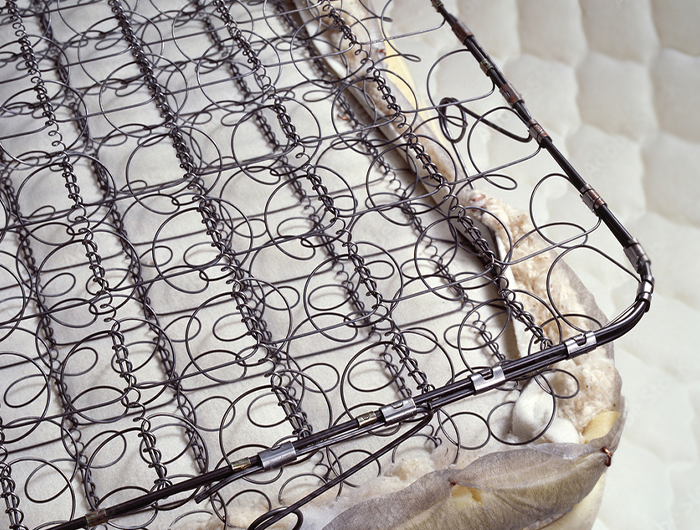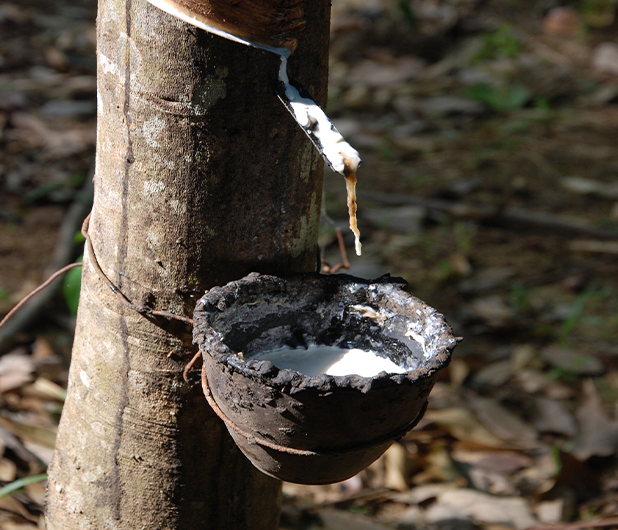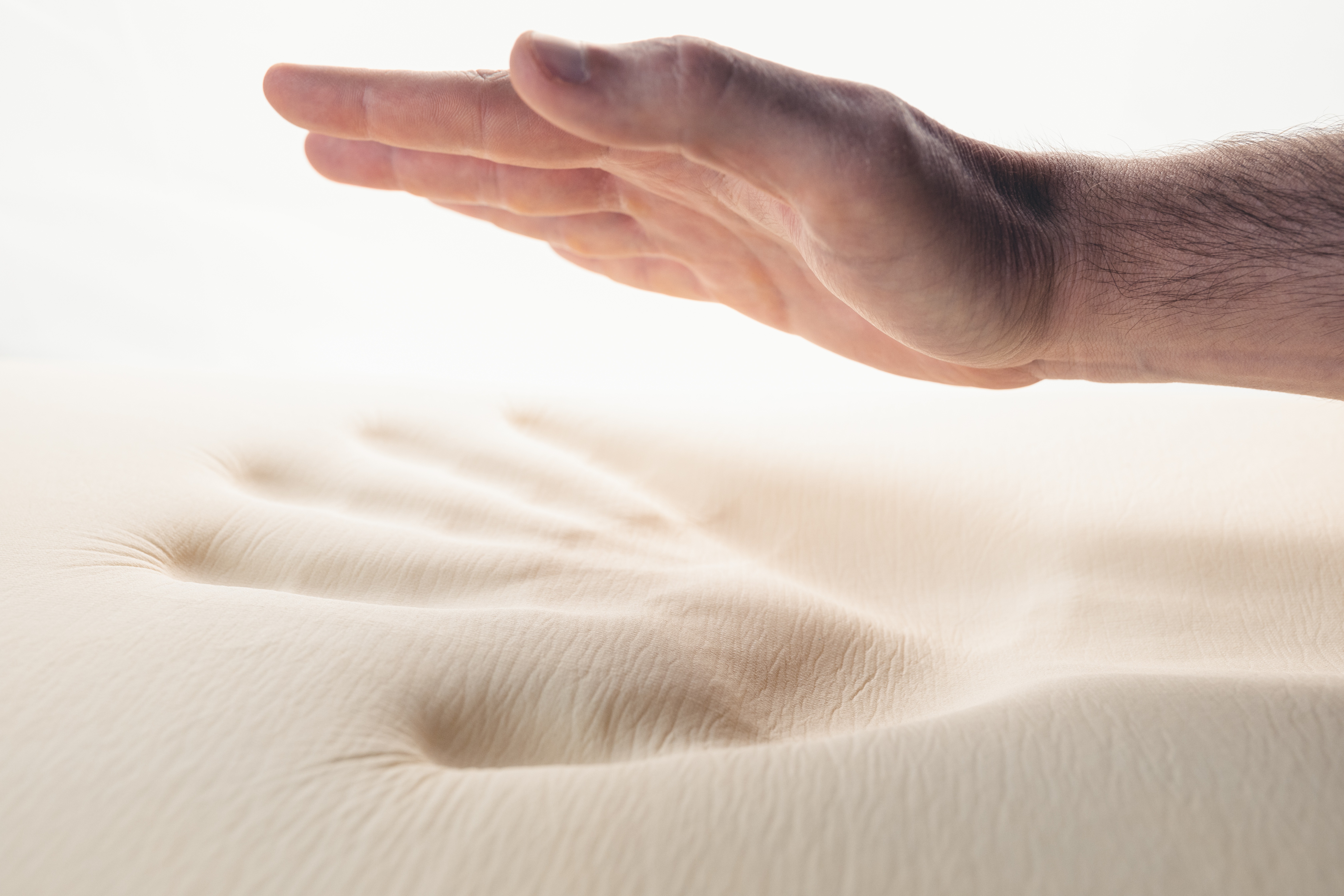In this article,
we're going to break down the differences between springs, latex, and memory foam, as well as their pros and cons, with no memory foam bias.

Let's take a look at the general characteristics and differences between the three materials.
| Innerspring | Latex |
Memory foam |
|
| Ingredient |
Metal springs
|
Rubber tree sap | Polyurethane |
| Noise | Squeaks | None | None |
| Cushioning | Firm |
Soft
|
Soft |
| Elasticity |
High
|
High
|
Low
|
| Temperature sensitivity | Low |
High
|
High
|
| Shock absorption | Low | Medium |
High
|
1. Spring
When we think of a mattress, the first thing that comes to mind is usually a spring mattress.
Spring mattresses have a long history, dating back to the 1800s.

The first spring mattress was developed in 1865, but it wasn't until the birth of the Simmons brand in 1870 that they became popular. In the past, mattresses were made from materials like wood, hay, cloth, and wool, which made sleeping a vulnerable experience due to pests and poor hygiene. The Industrial Revolution brought us the familiar spring mattress we know today, which comes in two main types: the traditional "bonnell spring" with interconnected coils, and the more modern "pocket spring" with individual springs wrapped in fabric pockets.
2. Latex
If you have a friend who has traveled to Southeast Asia, they might have heard of latex.
Latex has been a hit material to replace spring mattresses worldwide for the past decade. It is said to be made from natural rubber trees, making it a safer option!

Latex is another term for natural rubber tree sap. It is made by coagulating the rubber tree sap and then hardening it. Most rubber is made synthetically from petroleum, but it causes serious issues when it comes into direct contact with the body, which is why latex was developed. In other words, latex is a type of rubber with high biocompatibility compared to regular rubber.
After separating the rubber from the rubber tree sap and refining it, it is foamed by adding various chemical additives such as foaming agents, hardeners, and cross-linking agents. The amount of natural latex included is determined during this process.
However, one thing to note is that 100% natural latex is a misleading term.
Although it is made entirely of natural latex, if it is composed of 100% natural latex, it will just be unyielding rubber! (Typically, a natural latex mattress refers to a product that uses 80% or more of rubber sap, and if the rubber sap content drops below 80%, it is classified as a synthetic latex product that is a mixture of synthetic rubber and natural latex.)
3. Memory foam
Memory foam is a type of polyurethane foam, also known as sponge. It was developed by NASA in 1966 to provide shock absorption and safety for astronauts during space travel. Compared to spring and latex, memory foam has not been applied to mattresses for a very long time.

Memory foam, also known as temper foam due to its property of slowly returning to its original shape, began to be commercialized in the 1980s and first appeared in the world as a Tempur-Pedic mattress in 1991.
Memory foam has also been widely used in medical applications. For example, it has been used for patients who need to lie on a hospital bed for a long period of time. It helps prevent pressure sores or ulcers caused by pressure on the same area of the body for an extended period of time.
Comparing the pros and cons of spring, latex, and memory foam at a glance
We've covered the basic concepts of the three materials,
but the most important thing is what advantages and disadvantages they can bring to us.
| Spring | Latex | Memory Foam | |
| Advantages | Relatively inexpensive. | Relatively environmentally friendly. | Comparatively new material. |
| Large selection of products | Can be used for a long time. | Effective in absorbing pressure and distributing body weight. | |
| Excellent elasticity and firmness. | Has both elasticity and softness. | support and comfort. | |
| Good breathability and not hot. | Has natural antimicrobial properties. | Excellent resilience. | |
| Disadvantages | Short replacement cycle. | Difficult to maintain | Inadequate ventilation. |
| Noise may occur with prolonged use. | Sensitive to heat and direct sunlight | Sensitive to temperature. | |
| Pain may occur when sleeping on your side. | May become hard and powdery | May emit odor. |
Innerspring mattress
Pros
- Excellent elasticity.
- Relatively affordable among the three materials.
- Relatively good breathability, and feels cooler compared to latex and memory foam.
- Specifications can vary depending on the rotation degree and number of springs used, and it can also come in a hybrid form with foam placed on top of the springs to provide both support and cushioning.
Cons
- Connected panels may cause rolling and lack of shock absorption. Independent spring forms have been introduced to compensate for this weakness, but the durability can still decrease and squeaking noise can occur with long-term use.
- If the individuals sharing the mattress have a significant weight difference, one side of the mattress may sag more.
- The mattress may not fill in the gaps of the body's curves, causing pressure to concentrate on certain parts of the body during sleep.
- Shorter lifespan and frequent replacement needed.
Latex Mattress
Pros
- Has a suitable elasticity and softness
- Considered the most eco-friendly among the three materials
- Can last for more than 15 years with natural antibacterial properties
- Effective in distributing body weight and relieving back pain
Cons
- 100% natural latex products are rare, and it can be difficult to distinguish between synthetic and natural latex. When choosing a latex product, always check that it is made with at least 80% natural latex to ensure durability and longevity.
- Harvested manually from living rubber trees, resulting in higher product prices
- Vulnerable to heat, which can cause hardening (powdering) and respiratory problems
- Sensitive to direct sunlight and requires careful management.
Memory Foam Mattress
Pros
- Absorbs pressure and reduces vibrations, even if there is tossing and turning.
- Returns to its original shape, filling in the gaps of body contours while lying down, which is beneficial for pressure relief.
- Offers strong support and maintains its resilience even after long-term use.
- Effective in relaxing muscles and supporting the spine during sleep, without causing strain on the body even when sleeping on the side.
Cons
- Low-density products are affordable, but have a short lifespan
- Heavier than inner spring mattresses as they are completely filled with foam
- May feel hot relatively easily
- May produce an odor if not sufficiently ventilated during production and become even softer during hot weather
You've now clearly identified the pros and cons of each material. As each material has its own appeal, you can think about which one is suitable for your situation and choose accordingly. Of course, don't forget that you need to try each mattress yourself to know if it fits your body. So, have a good night tonight!







